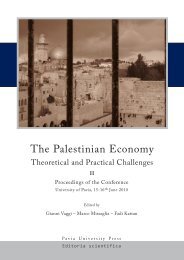Musica che affronta il silenzio - Scritti su Toru Takemitsu - Pavia ...
Musica che affronta il silenzio - Scritti su Toru Takemitsu - Pavia ...
Musica che affronta il silenzio - Scritti su Toru Takemitsu - Pavia ...
Create successful ePaper yourself
Turn your PDF publications into a flip-book with our unique Google optimized e-Paper software.
110<br />
Gianmario Borio<br />
structural aspects. Both avant-garde and pop music are closely linked to electronic technology,<br />
have strong institutional references and show a tendency to absorb whatever is alien to<br />
them. They represent the two sides of a historical divide of extraordinary importance in Western<br />
musical culture. Nowadays one may legitimately ask whether they are not in fact the two<br />
sides of the coin of the Western colonialist vocation. 4<br />
Cowell was the first of a series of American composers who turned to extra-European<br />
cultures in order to extend the compositional techniques and aesthetic insights they had developed<br />
in their work and that betrayed an ambivalent attitude, involving both attraction<br />
and repulsion, towards the European roots. Many of these musicians lived in California:<br />
John Cage, Lou Harrison, Colin McPhee, Alan Hovhaness, Harry Partch, and later on La<br />
Monte Young and Terry R<strong>il</strong>ey. In an article on the history of experimental music in the<br />
United States, written for the journal of the Internationale Ferienkurse für Neue Musik in<br />
Darmstadt immediately after his famous participation in 1958, Cage gave this parable as an<br />
explanation for the American interest in what lay beyond the Pacific Ocean:<br />
Men leaving Asia to go to Europe went against the wind and developed machines,<br />
ideas, and Occidental ph<strong>il</strong>osophies in accord with a struggle against nature; […] on<br />
the other hand, men leaving Asia to go to America went with the wind, put up a sa<strong>il</strong>,<br />
and developed ideas and Oriental ph<strong>il</strong>osophies in accord with the acceptance of nature.<br />
These two tendencies met in America, producing a movement into the air, not<br />
bound to the past, traditions, or whatever. (Cage 1980: 73)<br />
It was thus in the United States that musical experimentation found a fert<strong>il</strong>e terrain and almost<br />
unwittingly tended towards Eastern conceptions of music. In an essay written a<br />
decade previously, dealing with the convergence between Eastern and Western conceptions,<br />
Cage specified five areas in which this tendency was made manifest: the<br />
abandonment of construction based on motifs or themes, the poly-stratification of parts<br />
without the need for harmonic control, the structural conception of rhythm, the use of<br />
percussive sounds, and the interest in non-temperate scales. (Cage 1946: 111-115)<br />
Elliott Carter, an American composer with a very different aesthetic, explained<br />
during the Tokyo Conference that it was a characteristic trait of Western music that<br />
composers were concerned with the ‘creation and vivid presentation of differing musical<br />
characters and expressions’ (Carter 1961: 126). 5 In this pur<strong>su</strong>it of multiplicity and<br />
specificity they had something in common with Eastern performers, who invent as they<br />
improvise. Nonetheless this creative activity is not ‘caught in the chains of time’ and the<br />
works can be seen as the re<strong>su</strong>lt of a ‘choice from among many imagined improvisations’<br />
(Carter 1961: 127). 6 This tendency to an increasing syntactic differentiation – which<br />
4 In terms of the avant-garde I have tried to give an answer in Borio (2009).<br />
5 Also in Carter (2008: 163).<br />
6 Also in Carter (2008: 163-164).

















